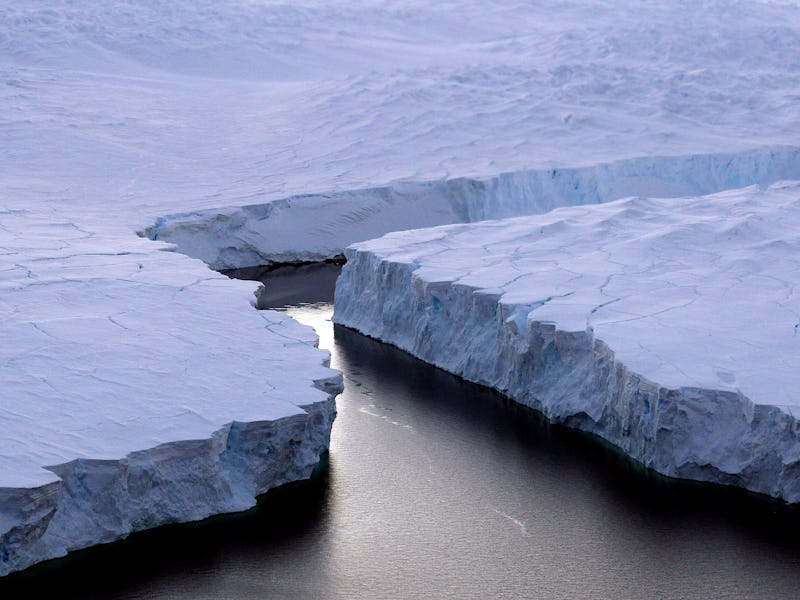Irreversible Sea Level Shifting Antarctic Ice Collapse Could Be Prevented
The latest horrifying sea level rise projection comes with a side of hope.

Projections of what the world is going to look like in the coming decades and centuries are bleak, and they only ever seem to get bleaker. For anyone paying close attention, it’s very literally depressing. The latest study to shake up climate science is both more of the same and something different; it is another in a long series of warnings, but one that comes with some hope.
The research, published in Nature, shows that if we do nothing to curb greenhouse gas emissions, the West Antarctic Ice Sheet could begin to collapse in just a few decades time, causing rapid sea level rise that would wipe out the planet’s coastal cities and countries. But aggressive action to curb fossil fuel use — that is ambitious but within the realm of possibility — would preserve most of Antarctica’s ice, causing only a small amount of sea level rise, slowly enough for humans to mitigate and adapt.
Melt from above and below can contribute to the destabilization of Antarctica's ice sheets.
Antarctica is the wildcard when it comes to predicting the climate change future. Here’s why: Antarctica is made of vast shelves of ice that extend out from the continent but are still attached to it. For these shelves to contribute to sea level rise, they don’t need to melt, they only need to detach from the continental base. As chunks break off into icebergs, they displace an area of water equal to their mass; it is this action, and not their eventual melt, that causes global sea level to rise.
It’s this that makes Antarctica such an important area of research. If the shelves destabilize and collapse, the result would be dramatic sea level rise that could happen very quickly. In all, Antarctic melt has the potential to raise global sea levels more than 50 feet, although this could take centuries.
The predictions of this latest research are different from what has come before, thanks to tweaks in the computer model that tries to approximate how the ice sheets will react to warming air and oceans. This updated model pays more attention to the way that warm air melts the ice from above, causing crevasses that weaken the shelves and can ultimately contribute to their collapse.
The scientists are pretty sure their updates are an improvement, because for the first time the model was able to recreate conditions seen in Earth’s ancient past. There have been times in the planet’s history when sea levels were 20 or 30 feet higher than they are today, even though temperatures were not much higher. Until now, our existing climate models couldn’t account for these observations. But this one did a good job recreating two warm moments in Earth’s past: The last interglacial period, from 130,000 to 115,000 years ago, and the Pliocene, about three million years ago.
This could be the future of the West Antarctic Ice Sheet, if humans don't curb their fossil fuel addiction.
When the researchers used the model to predict what may happen to Antarctica in the future, they used standard emission pathways developed by the Intergovernmental Panel on Climate Change. The results were dramatic. In RCP8.5, the scenario that assumes very little global action to combat climate change, West Antarctica began to collapse by 2050. By 2100, the ice disintegrates so fast as to contribute more than a foot of sea level rise per decade. By 2500, Antarctica’s collapse causes nearly 50 feet of global sea level rise.
But in RCP2.5, the scenario that assumes aggressive action to reduce fossil fuel use, and global emissions that peak and begin to decline by 2020, the picture is very, very different. Under this scenario Antarctica stays intact, contributing only a minute amount to global sea level rise all the way through this century and beyond.
In the middle picture, RCP4.5, the West Antarctic Ice Sheet disintegrates, but not nearly as quickly as the first scenario, contributing three feet of sea level rise by the end of this century. Even that much is enough to cause major problems for coastal cities and environments, and represents a much bigger estimate than previous research suggests. The IPCC’s own numbers suggest that RCP4.5 would result in one to two feet of sea level rise by 2100, including not just Antarctica’s contribution but those from Greenland and other sources as well.
Modelled sea level rise over time for different emission scenarios.
The model is still just a model, and it has room for continued improvement. “We are not saying this is definitely going to happen,” David Pollard, a researcher at Pennsylvania State University and a co-author of the paper, told the New York Times. “But I think we are pointing out that there’s a danger, and it should receive a lot more attention.”
A lot of climate change science suggests that the damage has been done. But this research suggests the opposite: Humans have a real opportunity to prevent a catastrophe, if we act now and act decisively. The commitments made by world leaders in Paris last December aren’t enough to get us there. It will take a sea change.
But the alternative is the irreversible destruction of coastal environments around the planet. Once Antarctica’s ice sheets are gone, the researchers note, it would take millennia for them to recover.